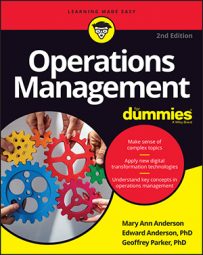When assessing quality for operations management, the first question you need to ask is, “What is a quality product?” Only your customer can answer this question because quality is what the customer says it is. A quality product means different things to different people, and expectations differ from product to product.
When asking potential customers to define a quality car, for example, you get an array of answers, ranging from “A quality car starts each and every time, gets good gas mileage, and has a high safety record” to “A quality car goes from 0 to 60 in 4.5 seconds and has a sleek design.”
Making matters even more challenging is that customers, in addition to having different expectations of quality, perceive and define each of those dimensions differently. Turning those perceptions into metrics that an operations manager can act on is one of the trickiest parts of managing quality. The wrong metrics can lead to a lot of wasted effort on improving aspects of a product that the customer doesn’t value.
For example, if a car company uses the wrong metric (measures the wrong aspect) to assess its pickup truck’s acceleration, then their attempts to improve this feature will be misdirected and wasted. By finding a metric that matches customer expectations, they could begin to make headway in improving the quality of this type of vehicle.
Moreover, a customer doesn’t usually define the quality of a product or service by a single metric. Instead, quality is defined across a range of dimensions. According to David Garvin of the Harvard Business School, these are the attributes that customers most commonly consider when defining quality:
Performance: The primary operating characteristics as perceived by the customer. Common performance metrics for an automobile are miles per gallon (MPG) and time to accelerate from 0 to 60 mph. Performance characteristics can often conflict because different customers value different factors.
Features: The secondary operating characteristics or the “bells and whistles.” These are the features that surprise the customer. Features often evolve and become primary operating characteristics — for example, anti-lock brakes, which were once considered features on a car, are now standard and considered part of performance quality.
Reliability: This dimension indicates how often the product malfunctions and doesn’t deliver on performance expectations. For an automobile, reliability is typically determined by how often the car must go back to the dealer to fix problems. But customer perception plays a role as well. If a car company makes its power locks almost inaudible and customers don’t like this, they may consider it a defect.
Durability: How long the product provides acceptable service. In automotive terms, “Do I trade in the vehicle when the warranty expires or hold onto it because it will probably outlast me?”
Aesthetics: How the product looks, feels, and sounds. Some types of products, including cars and computers, often sell better purely based on looks.
Safety: The risk of harm or injury from using the product. Safety relates to the risk of using the product correctly as well as the risks associated with using it in ways for which it wasn’t designed. How the auto performs in government crash tests is an important consideration to many customers.
Conformance: How well a product or service meets its design standards during actual use by the customer. For cars, a good example of a conformance requirement is advertised MPG versus MPG actually experienced by the customer. Few (if any) drivers actually get the posted MPG because the specification was obtained under ideal driving conditions with a professional driver.
In other types of manufacturing, conformance can be tested in the factory. The conformance metric can be crucially important because the firm often advertises the product based on these metrics, and if the product doesn’t perform, the customer is disappointed.
Serviceability: How well the product is serviced after the sale. This attribute relates to the speed, competence, and courtesy of customer service as well as to how the product was designed to accommodate service when a malfunction occurs.
Perceived quality: How the public perceives the quality of the product or service, which affects a company’s reputation in the marketplace. Brand loyalty is a potential outcome of perceived quality; many pickup owners strongly prefer either a Chevy or a Ford, and most are repeat buyers. An important point about perceived quality is that studies show a brand can lose it much more quickly than acquire it.
These attributes of quality provide a common language for assessing a product. You can measure and compare every product along these lines. And the key to developing quality products is knowing what customers expect and identifying actionable metrics for improvement based on these expectations. Reach out to the company’s marketing department to gather reliable information on these data points.

